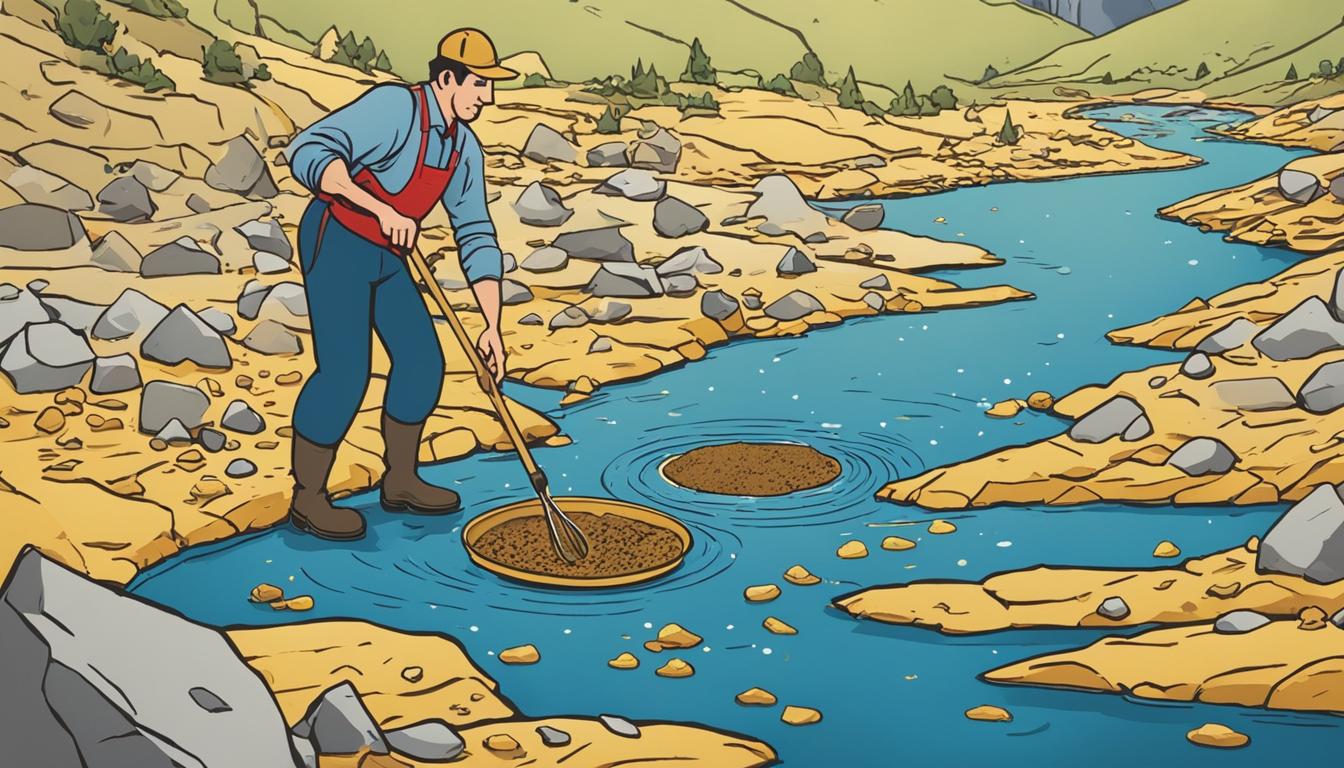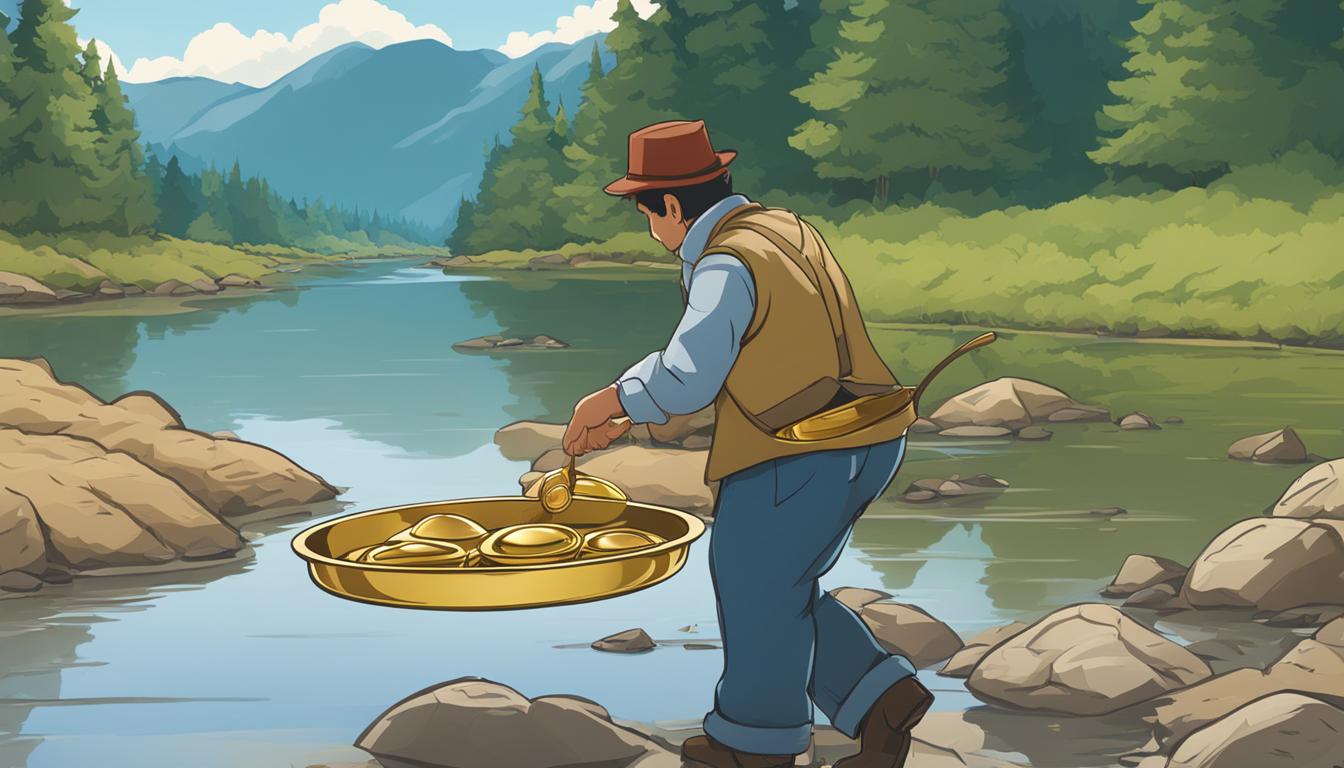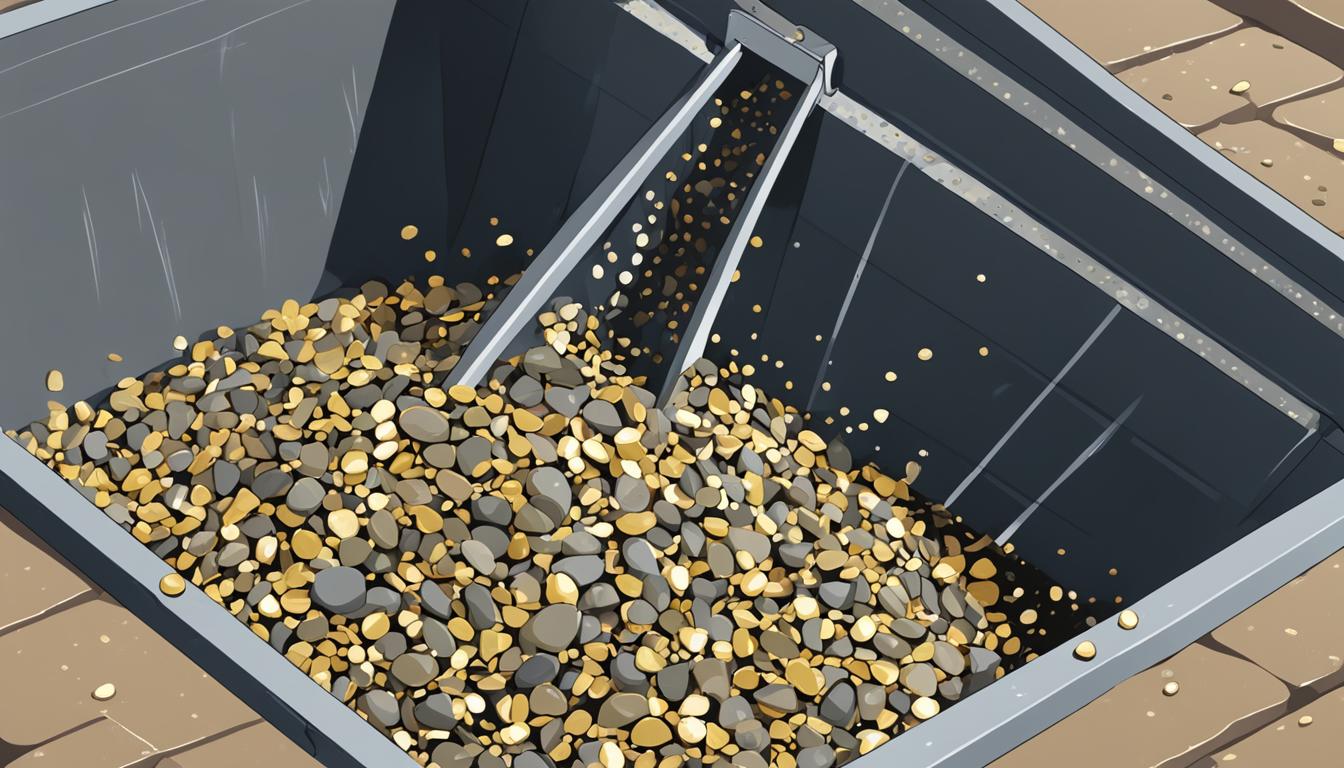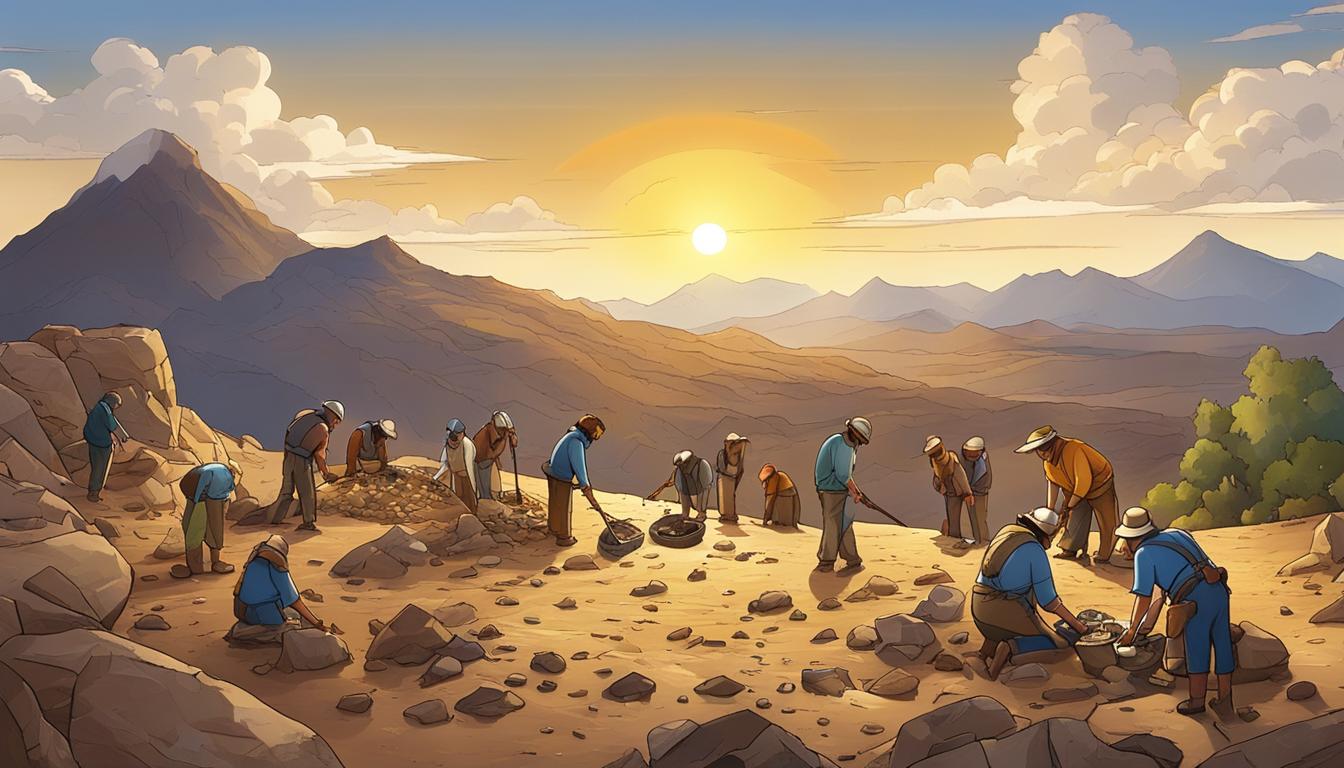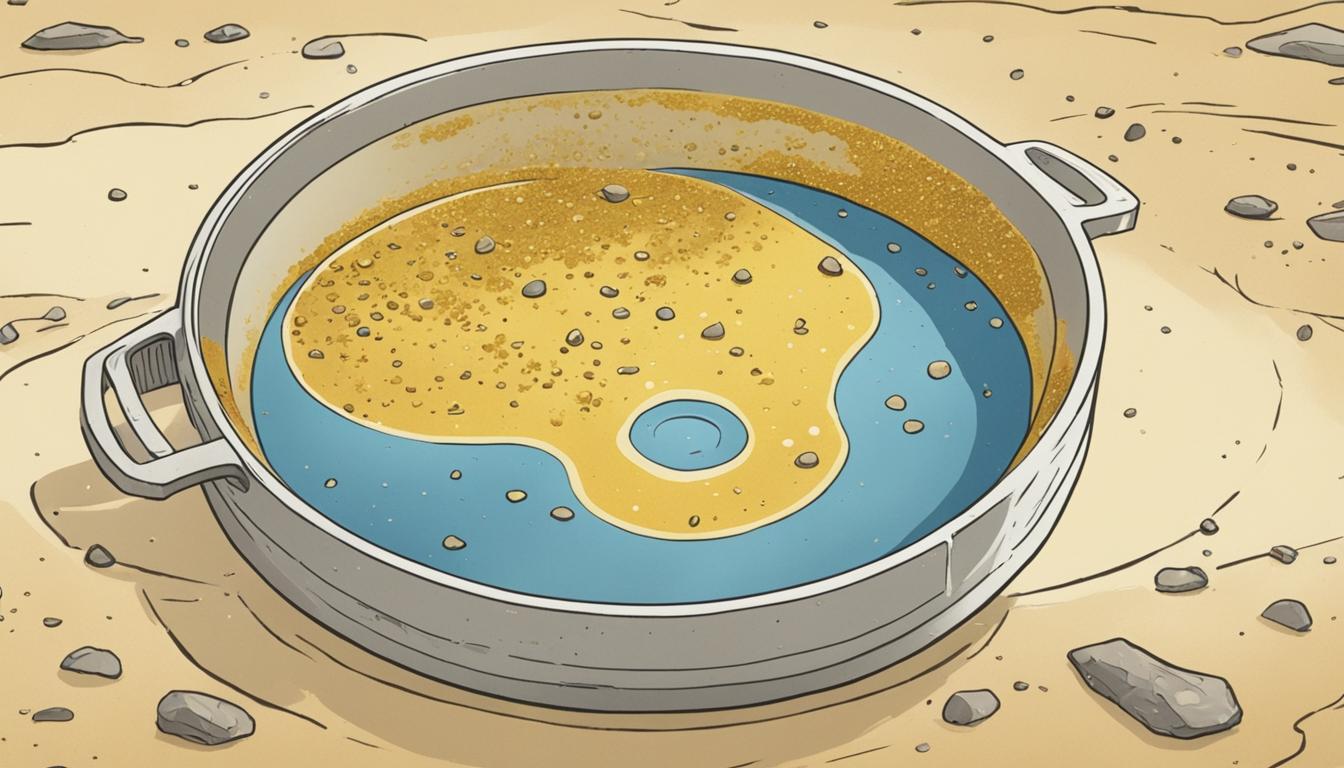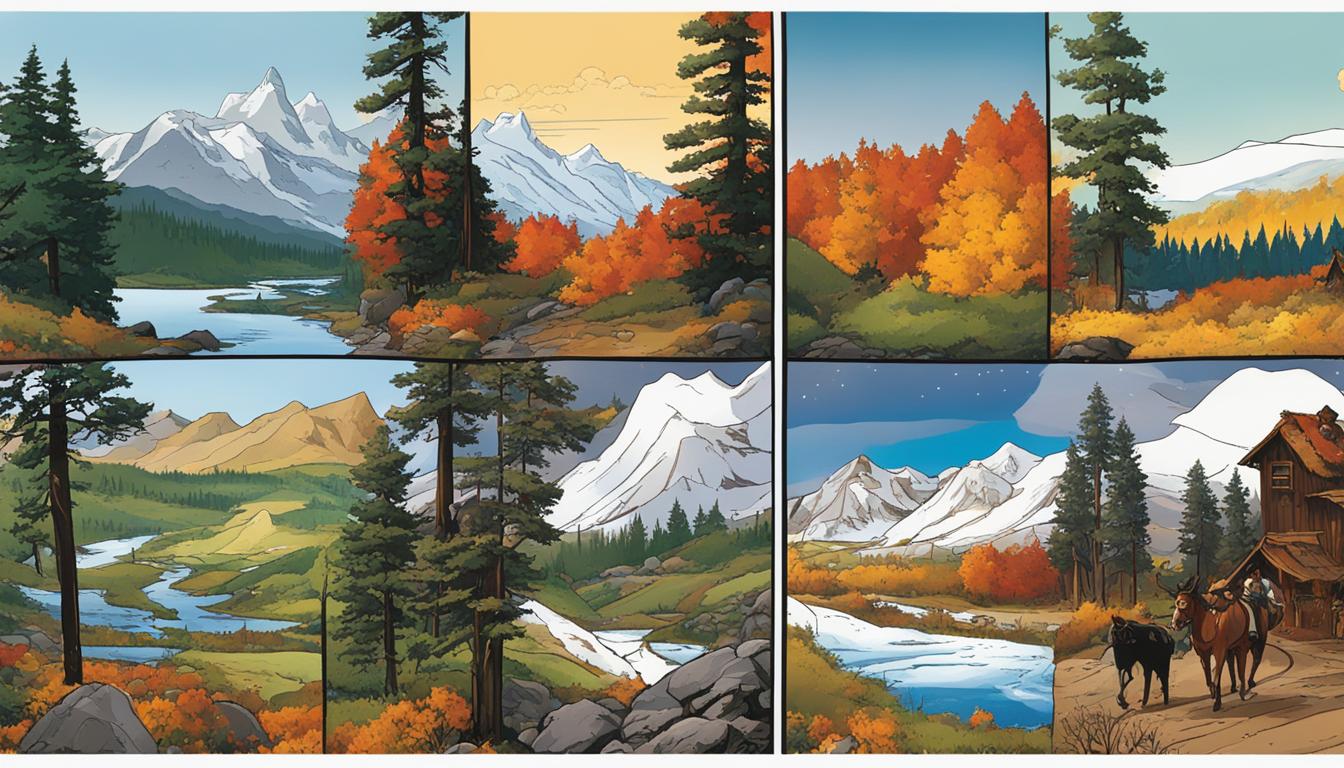
Welcome to the exciting world of gold panning! Whether you’re a beginner or looking to improve your technique, it’s important to know about the common mistakes that can hinder your success. By avoiding these pitfalls, you’ll be on your way to striking gold and having a memorable experience in no time.
Key Takeaways:
- Seasoning your gold pan is crucial for optimal efficiency.
- Digging deep enough is essential to uncovering gold deposits.
- Test holes can help determine the presence of gold before investing in heavy equipment.
- Understanding how gold accumulates can significantly improve your chances of finding it.
- Investing in heavy equipment should be done after gaining experience and knowledge.
Not Seasoning Your Gold Pan
One common mistake is not seasoning your gold pan before use. Newer plastic gold pans often have a sheen from the manufacturing process, causing water to pool rather than flow freely. To improve the efficiency of your gold pan, rough it up by using gravel and rough sand. This will help water move more freely, allowing you to better separate the gold from other materials.
The Importance of Seasoning
Seasoning your gold pan is an essential step in preparing it for efficient gold panning. When your pan is not seasoned, water tends to pool on the plastic surface, making it difficult to wash away undesired materials. By roughing up the surface, commonly referred to as seasoning, you create a more conducive environment for capturing gold.
| Steps to Seasoning Your Gold Pan: |
|---|
| 1. Fill your gold pan with a mixture of gravel and rough sand, ensuring it covers the entire surface. |
| 2. Holding the pan firmly, rub the gravel and sand against the plastic surface using circular motions. Apply pressure to create friction and roughen the sheen. |
| 3. Continue this process for a few minutes until the sheen is no longer visible, and the pan’s surface feels coarser. |
| 4. Rinse the pan thoroughly with water to remove any loose gravel and sand. |
| 5. Your gold pan is now seasoned and ready for use. |
By taking the time to properly season your gold pan, you enhance its efficiency and increase your chances of capturing gold effectively. Don’t skip this essential step in your gold panning endeavors.
Not Digging Deep Enough
Another mistake made by beginners is not digging deep enough. Gold is heavy and tends to sink to the lowest point over time. Most gold is found on top of the bedrock of the river, so it’s important to concentrate your efforts on working the material just above the hard pack or bedrock. Avoid wasting time on loose material, known as overburden, which is unlikely to contain much gold. While some gold may be found in the top layers, it is typically in smaller quantities compared to what can be found deeper, where gold has had more time to accumulate.
If you’re not digging deep enough, you’re missing out on the potential for finding more gold. The deeper you go, the higher your chances of striking a significant amount of gold. Digging down to bedrock exposes the layers of sediment where gold has settled over time, increasing your chances of finding valuable deposits.
Pro Tip: Concentrate your digging efforts near bedrock to maximize your chances of finding gold that has sunk closer to the surface over time.
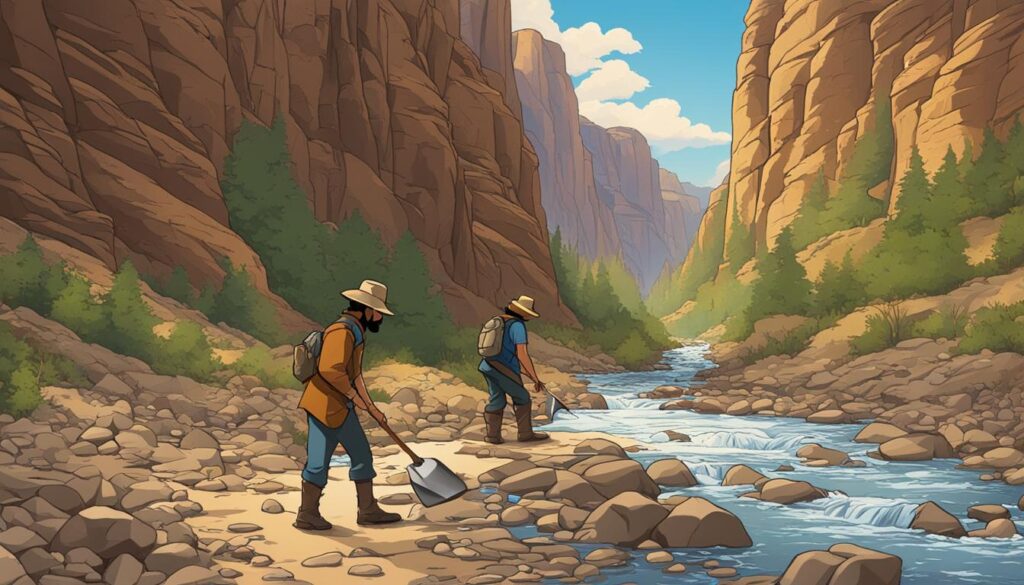
Not Digging Test Holes Before Setting Up Heavy Equipment
One common mistake made by many beginners in gold panning is the failure to dig test holes before setting up heavy equipment such as dredges or sluice boxes. It is imperative to take the time to test the areas for gold deposits before making any investments and commencing work.
Gold is not uniformly distributed in rivers; instead, it occurs in paystreaks or pockets in specific locations. In order to determine the presence or absence of gold, it is recommended to use your gold pan as a sampling tool and pan materials from various locations. This process of sampling and scouting the area will enable you to concentrate your efforts in areas that are more likely to yield productive results.
By digging test holes and panning materials from different locations, you can assess the gold concentration in each area and identify promising spots for productive gold prospecting. Sampling is a crucial element of the gold panning process as it allows you to determine the presence of gold before committing to heavy equipment.
“Sampling is the key to successful gold prospecting. By digging test holes and panning materials from various locations, you can increase your chances of finding gold and avoid wasting time and resources on unproductive areas.” – John Smith, experienced gold prospector
Gold Prospecting Tips: Determining Gold Presence
When conducting the sampling process, it is important to follow these gold prospecting tips to effectively determine the presence of gold:
- Choose different locations along the river or stream to perform the sampling.
- Ensure to dig test holes in strategic spots that are likely to contain gold deposits.
- Use your gold pan to collect samples of the material from each test hole.
- Pan the samples carefully, focusing on separating the heavy materials, including gold, from the lighter materials.
- Observe the presence of visible gold flakes or particles in the pan.
- Repeat the process from multiple test holes to obtain a broader assessment of the gold concentration in the area.
By diligently digging test holes and conducting proper sampling techniques, you can make informed decisions about where to set up heavy equipment and optimize your chances of finding gold.
Not Knowing How Gold Accumulates – Learn to Concentrate Your Efforts
When it comes to gold panning, beginners often overlook the important aspect of understanding how gold accumulates in order to maximize their chances of finding this precious metal. By learning about gold accumulation and concentrating your efforts in the right areas, you can improve your gold panning success.
Gold tends to accumulate in areas where there is a change in water flow. Slower-moving water below rapids and waterfalls, deep pools, and the downstream side of boulders are all promising locations to search for gold. Additionally, inside bends of meanders and the upstream ends of sand or “point” bars are known to be good spots for finding fine gold. Another place to look for gold is in bedrock crevices or pockets, as they act as natural riffles that can trap gold particles.
To help you visualize these gold accumulation areas, here is a table that highlights the different locations and features where gold is commonly found:
| Gold Accumulation Areas | Features |
|---|---|
| Slower-Moving Water | Below rapids and waterfalls |
| Deep Pools | Where the water flow becomes calmer and deeper |
| Downstream Side of Boulders | Where the flowing water creates eddies and slows down |
| Inside Bends of Meanders | Curves in the river where slower water flow occurs |
| Upstream Ends of Sand or “Point” Bars | Areas where sediment and gold settle as the water flow changes direction |
| Bedrock Crevices or Pockets | Deep cracks and crevices in the river bedrock that can trap gold |
Remember, these areas are just starting points for your gold panning adventures. While gold is more likely to accumulate in these locations, it doesn’t guarantee that you will find gold every time. Exploring different spots and experimenting with your techniques will help you hone your skills and increase your chances of finding gold deposits.
Note: For a visual representation of gold accumulation areas, refer to the image below:
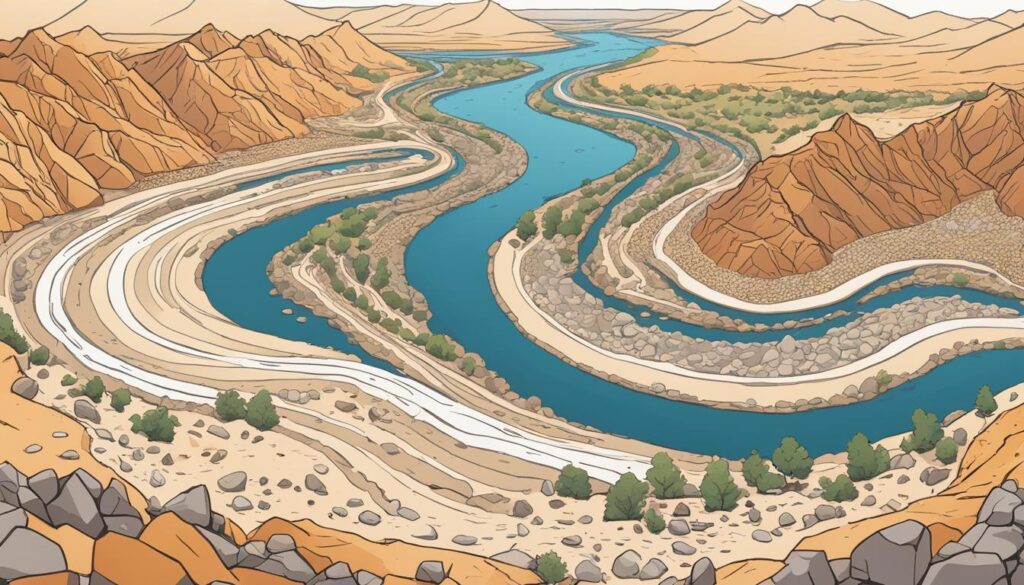
“To find gold, you need to think like gold and understand how it accumulates in specific areas. By focusing your efforts in the right locations, you can increase your chances of striking gold.”
Investing in Heavy Equipment Too Soon
Many beginners in the world of gold panning get carried away with excitement and make the mistake of investing in heavy equipment like dredges or sluice boxes too soon. It’s crucial to remember that gold panning is a skill that requires practice and experience before making significant financial commitments.
Instead of diving headfirst into expensive equipment, take the time to learn the basics of gold panning and hone your skills. Starting with simple equipment like gold pans allows you to develop a fundamental understanding of the process, including how to identify potential gold-bearing areas and effectively extract gold from river sediment.
A helpful tip is to join a gold panning club in your area. These clubs provide a supportive community of experienced members who can offer guidance, tips, and advice. Learning from those who have already mastered the art of gold panning can save you from costly mistakes and ensure you’re equipped with the knowledge to make informed decisions about equipment investments.
“Take the time to learn the basics, start small, and gradually upgrade your equipment as your skills and knowledge grow. Patience and experience are key to successful gold panning adventures.”
By starting with simple equipment and gradually upgrading as your skills improve, you can avoid wasting money on equipment that may not be suitable for your skill level or the specific areas you plan to prospect in. Remember, gold panning is not just about the equipment; it’s also about developing an understanding of the geological features and potential gold deposits in your chosen locations.
Benefits of Joining a Gold Panning Club
Joining a gold panning club offers numerous advantages for newcomers to the hobby:
- Access to experienced members: Learn from seasoned gold prospectors who can provide valuable advice and techniques.
- Guided field trips: Join organized outings where club members explore and pan for gold in proven areas.
- Sharing knowledge and stories: Engage in friendly discussions and learn from the experiences of others.
- Equipment demonstrations and recommendations: Get hands-on experience with different tools and learn about their pros and cons.
- Networking opportunities: Connect with fellow enthusiasts, potentially forming partnerships or friendships for future prospecting endeavors.
Joining a gold panning club not only enhances your learning journey but also helps build a supportive community of like-minded individuals who share your passion for gold panning.
When to Consider Upgrading Your Equipment
As your skills and knowledge of gold panning progress, you may find it appropriate to upgrade your equipment to increase efficiency and optimize your chances of finding gold. Consider upgrading your equipment when:
- You have gained substantial experience and feel confident in your gold panning techniques.
- You have thoroughly researched and identified areas with high gold-bearing potential.
- You have consulted with experienced gold panners or professionals and received recommendations based on your specific goals and locations.
| Common Gold Panning Equipment | Pros | Cons |
|---|---|---|
| Gold Pan | – Affordable and easily accessible – Suitable for beginners – Versatile for various types of gold panning techniques |
– Limited capacity for processing larger quantities of material – May not be suitable for advanced prospecting in some areas |
| Dredge | – Efficiently processes large volumes of material – Allows for deeper excavation – Suitable for areas with abundant gold deposits |
– Expensive investment – Requires permits and compliance with regulations – Not suitable for all gold panning locations |
| Sluice Box | – Ideal for processing larger volumes of material – Captures finer gold particles effectively – Can be operated with a small team |
– Bulky and requires transportation – Setup and cleanup may be more time-consuming – Requires a steady water source |
Table: Common Gold Panning Equipment Pros and Cons
Remember, investing in heavy equipment should align with your skill level, budget, and the specific locations you plan to prospect in. The goal is to strike a balance between investing in equipment that meets your needs and prevents unnecessary financial strain.
By following the advice of experienced gold panners, gaining practical experience, and making informed decisions, you can minimize mistakes and maximize your potential for successful gold panning adventures.
Not Respecting Mother Nature
One crucial mistake beginners make is not respecting the environment while gold panning. It’s important to be aware of the potential impact on water quality, soil erosion, and the well-being of aquatic life. To engage in responsible gold panning, follow these guidelines:
- Avoid washing soil and vegetation into streams: When panning, make sure to dispose of excess soil and vegetation properly, away from water sources. This helps maintain water quality and prevents contamination.
- Don’t dig in unstable stream banks: Digging in unstable stream banks can result in soil erosion and damage to both the landscape and aquatic ecosystems. Instead, focus on areas that won’t cause harm or disrupt the natural balance.
- Protecting aquatic life: Take precautions to protect aquatic life while panning for gold. Avoid disturbing habitats and spawning areas, and handle any aquatic creatures you encounter with care.
“Responsible gold panning not only preserves the environment but also ensures that future generations can enjoy the same experiences and opportunities.”
It’s also important to familiarize yourself with relevant mining terms and glossary. This knowledge will enhance your understanding of the activity and help you make informed decisions while panning.
Common Mining Glossary
| Term | Definition |
|---|---|
| Bedrock | The solid rock layer underlying the loose material in a river or stream. |
| Overburden | The layer of loose material (such as sand, silt, and gravel) covering bedrock. |
| Riffles | Narrow grooves or ridges in a gold pan or sluice box that trap heavier materials, including gold. |
| Sluice box | A long, narrow box or channel with riffles used to extract gold from sediment and water. |
| Dredging | The process of removing sediment from the bottom of a water body to extract gold or other minerals. |
By following responsible gold panning practices and educating yourself about the environment and mining terminology, you can enjoy this hobby while minimizing your impact on nature and protecting its delicate ecosystems.
What You Need for Gold Panning Adventures
Before embarking on your gold panning adventures, it’s important to have the essential items and mindset to increase your chances of success. Here’s a list of what you’ll need:
- Gold Pan: The most essential tool for gold panning, a sturdy gold pan allows you to sift through sediment and separate the gold from other materials.
- Spade or Hand-Shovel: A small spade or hand-shovel is useful for transferring material from the river to your gold pan, making your panning process more efficient.
- Comfortable Seating Option: Gold panning requires patience, so it’s crucial to have a comfortable seating option for extended periods. Consider a lightweight portable seat or stool.
- Secure Container: You’ll need a secure container to store your findings. Opt for a waterproof and durable container that can safely hold your gold without the risk of loss.
Additionally, make sure to allocate sufficient free time for your gold panning activities. Success in finding gold may not come immediately, so cultivating patience is key to enjoying the experience.
Remember, gold panning is not only about finding gold but also about immersing yourself in nature and enjoying the process. So, gather your gold panning gear, prepare yourself mentally, and embark on your gold panning adventures!
Steps to Gold Panning Success
To increase your chances of finding gold while panning, follow these steps:
-
Collect gravel, sand, and sediment from the river using a shovel or scoop.
- Shake and swirl the pan to help the gold settle at the bottom.
- Use a shallow angle to let the current wash away the top layers of silt and sand, repeating this step to gradually remove lighter materials.
- Continue swirling the pan to help the gold flakes settle further, and carefully pick them out using tweezers or a snifter bottle.
- Repeat the process multiple times until only black sand remains, which can indicate the presence of fine gold.
By following these steps, you can effectively extract gold from river sediment.
Conclusion
Gold panning can be a truly rewarding and enjoyable hobby, providing adventure and the opportunity to strike gold. However, to maximize your chances of success, it is crucial to avoid common mistakes that many beginners make in their early gold panning adventures.
One of the key mistakes to avoid is not seasoning your gold pan before use. By roughing up the surface of your plastic gold pan with gravel and rough sand, you can improve its efficiency and ensure that water flows freely, enhancing your ability to separate the gold from other materials.
Digging deep enough is another important aspect. By focusing your efforts on the material just above the bedrock of the river, you can increase your chances of finding gold. Conducting test holes before setting up heavy equipment is also essential, as it allows you to determine the presence or absence of gold deposits in an area.
Moreover, it is crucial to respect the environment while gold panning. By practicing responsible gold panning techniques and being aware of the impact on water quality, soil erosion, and aquatic life, you can ensure the preservation of nature and the sustainability of this hobby.
By understanding how gold accumulates in rivers, investing in equipment gradually, and adhering to local laws and regulations, you can improve your gold panning skills and increase your chances of striking gold. Remember, it takes patience, practice, and a bit of luck to find success in gold panning. So get out there, enjoy the adventure, and may you uncover your own golden treasures!
Source Links
- https://www.goldfeverprospecting.com/gopaandprmi.html
- https://www.americanminingrights.com/how-to-pan-for-gold/
- https://jjpryor.medium.com/what-is-gold-panning-a-complete-beginners-guide-e5b62ef8b3fe

Meet Ryan Conlon, the passionate owner and driving force behind Pan for Treasure.
With an unwavering love for the art of gold panning, Ryan has transformed his enthusiasm into a thriving community hub for fellow treasure seekers. [email protected]
A seasoned gold panning enthusiast, Ryan’s journey began with a simple pan and a dream, evolving into a deep appreciation for the history, geology, and thrill of uncovering precious metals.


